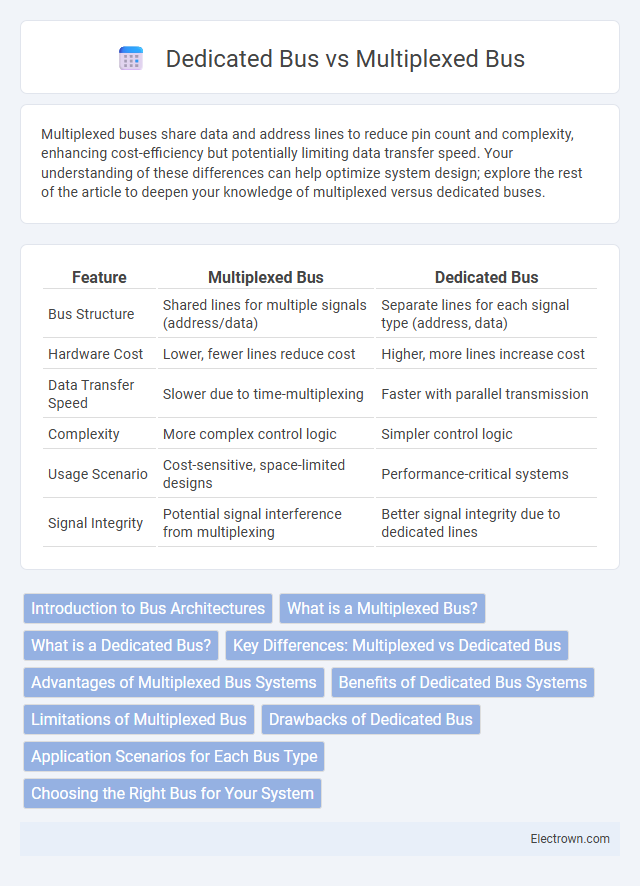Multiplexed buses share data and address lines to reduce pin count and complexity, enhancing cost-efficiency but potentially limiting data transfer speed. Your understanding of these differences can help optimize system design; explore the rest of the article to deepen your knowledge of multiplexed versus dedicated buses.
Table of Comparison
| Feature | Multiplexed Bus | Dedicated Bus |
|---|---|---|
| Bus Structure | Shared lines for multiple signals (address/data) | Separate lines for each signal type (address, data) |
| Hardware Cost | Lower, fewer lines reduce cost | Higher, more lines increase cost |
| Data Transfer Speed | Slower due to time-multiplexing | Faster with parallel transmission |
| Complexity | More complex control logic | Simpler control logic |
| Usage Scenario | Cost-sensitive, space-limited designs | Performance-critical systems |
| Signal Integrity | Potential signal interference from multiplexing | Better signal integrity due to dedicated lines |
Introduction to Bus Architectures
Bus architectures in computer systems define how data, address, and control signals are transmitted between components; a multiplexed bus shares lines for multiple signals, reducing the number of physical connections and saving cost and complexity, while potentially impacting data transfer speed. Dedicated bus architecture assigns separate lines for each signal type, enabling faster and simultaneous data transfer at the expense of increased wiring and hardware requirements. The choice between multiplexed and dedicated buses influences system performance, cost, and scalability depending on application demands.
What is a Multiplexed Bus?
A multiplexed bus is a communication system where multiple signals share the same physical lines by transmitting data sequentially, reducing the number of required conductors. This approach contrasts with a dedicated bus, which uses separate lines for each signal to allow simultaneous data transfer. Multiplexed buses optimize hardware resources and are commonly used in microprocessors and memory interfaces to balance cost and complexity.
What is a Dedicated Bus?
A Dedicated Bus is a communication pathway in computer architecture that exclusively connects specific components, ensuring direct and uninterrupted data transfer without sharing bandwidth with other devices. This type of bus enhances performance by reducing latency and minimizing data collisions, making it ideal for high-speed, time-sensitive operations within your system. Unlike Multiplexed Buses, which share lines for multiple signals, Dedicated Buses provide a single, purpose-built channel tailored to the connected hardware's requirements.
Key Differences: Multiplexed vs Dedicated Bus
Multiplexed buses transmit multiple signals or data types over shared lines by time-sharing, reducing pin count and wiring complexity, while dedicated buses allocate separate lines for each signal, providing simultaneous data transfer with higher speed and lower latency. Multiplexed bus designs are cost-effective and space-saving but can introduce timing overhead and potential signal interference compared to the straightforward and isolated pathways of dedicated buses. Selecting between multiplexed and dedicated buses depends on system requirements for bandwidth, complexity, and physical constraints, impacting overall system performance and design scalability.
Advantages of Multiplexed Bus Systems
Multiplexed bus systems reduce the number of physical connections by sharing data, address, and control lines, leading to lower hardware complexity and cost. They enable efficient use of bus lines, improving signal integrity and reducing pin count on integrated circuits. This optimization also enhances system scalability and flexibility in communication between components.
Benefits of Dedicated Bus Systems
Dedicated bus systems enhance communication efficiency by providing exclusive pathways for data transfer, reducing latency and minimizing signal interference. These buses offer higher bandwidth capacity, enabling faster and more reliable data transmission between components in computing or networking environments. Targeted data flow management in dedicated bus architectures improves overall system performance and stability compared to multiplexed bus solutions.
Limitations of Multiplexed Bus
Multiplexed buses reduce pin count by sharing address and data lines, but this can lead to slower data transfer rates due to the need for time multiplexing. The constant switching between address and data on the same bus lines introduces latency and increases the complexity of bus control logic. Limited bandwidth and increased signal interference also restrict performance compared to dedicated buses, which have separate lines for address and data, enabling faster and more reliable communication.
Drawbacks of Dedicated Bus
Dedicated bus systems often suffer from increased hardware complexity and cost due to the requirement of separate communication lines for each data path. This design limits scalability as adding more devices demands additional buses, leading to physical space constraints and inefficiencies. Your system's flexibility can be restricted, impeding performance optimization in dynamic or evolving network environments.
Application Scenarios for Each Bus Type
Multiplexed buses are commonly used in systems where minimizing the number of physical connections is crucial, such as in microcontrollers and embedded systems with limited pin availability, effectively handling address and data signals on a shared line to reduce cost and complexity. Dedicated buses excel in high-performance applications like modern CPUs and GPUs, where separate lines for address, data, and control signals ensure faster and simultaneous data transfer, improving bandwidth and reducing latency. Your choice depends on the trade-offs between cost, speed, and system complexity inherent in the intended application scenario.
Choosing the Right Bus for Your System
Choosing the right bus for your system hinges on balancing complexity, cost, and performance requirements. Multiplexed buses offer reduced pin count and lower wiring complexity, making them ideal for compact and cost-sensitive designs but may introduce latency due to shared data and address lines. Dedicated buses provide higher data throughput and faster communication speeds, suitable for high-performance systems where speed and reliability are critical, despite increased hardware complexity and cost.
Multiplexed Bus vs Dedicated Bus Infographic

 electrown.com
electrown.com